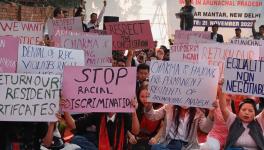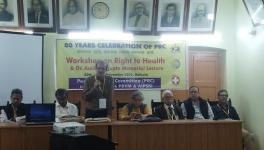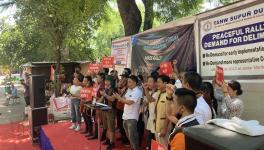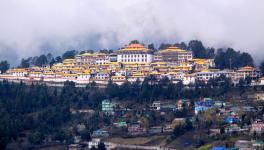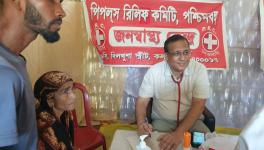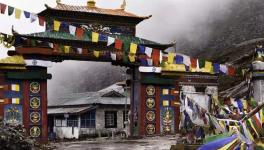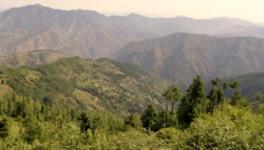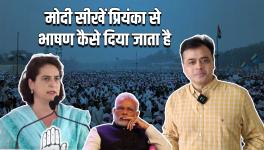Farce to Tragedy to Farce: Timeline of the PRC Issue

Image Coutesy: ANI
After around four days of violence, Arunachal Pradesh has limped back to a relative calm. The violence had arisen out of protests against providing Permanent Residency Certificates (PRC) to six communities living in Lekang circle in Namsai district and the retired servicemen – mostly Gorkhas – residing in Vijaynagar (originally known as Da-Wo-Di) in Changlang. However, according to unconfirmed ground reports, the violence that was witnessed in Itanagar and Naharlagan was not triggered by the PRC issue alone.
The people of Lekang circle in Namsai district have been demanding PRCs for a long time. This is premised on the first cadastral survey of the area carried out in 1968 where the people belonging to the Adivasi, Deori, Moran, Ahom, Mishing, Sonowal Kachari and Assamese (Koibarta) communities have resided prior to India’s independence. Arunachal Pradesh became a state only in 1987. Hence, these communities have demanded granting of PRCs, taking 1968 as the cut-off year. Similarly, in Vijaynagar in Changlang, retired servicemen from the Assam Rifles had settled following the 1962 war with China. The land that was acquired for their settlement was taken on lease, expiring in 2020. However, the Yobin community, which shares the same area with them is not too keen on the retired servicemen and their families living there on a renewed lease. What complicates the situation further is that the Yobin community, with a population of around 2,000, is not recognised as a Scheduled Tribe (ST). In fact, the Lok Sabha member for Arunachal East, Ninong Ering had forwarded proposals to the National Commission for Scheduled Tribes as well as to the Ministry of Home Affairs to have the community recognised as STs. These requests and proposals however fell on deaf ears.
Also Read | Big Dams in Arunachal-Assam Border likely to Resume Work after NGT Green Signal
Arunachal Pradesh had been simmering for a while on the PRC issue. On May 1, 2018, the government of Arunachal Pradesh constituted a Joint High Powered Committee (JHPC) under the chairmanship of Environment and Forests minister, Nabam Rebia. However, on May 22, communities demanding PRCs shut down the highway at Lekang. On November 27, the same year, several community-based organisations in Lekang imposed a 48 hour shutdown demanding PRCs. What made this shutdown different was that they allegedly received support from Assam-based organisations. As is the case, whenever a shutdown is imposed, those uninvolved in the political or other questions tend to view it more as a nuisance.
A slow fuse was however lit on December 7 and 8 last year, when Chief Minister Pema Khandu and deputy chief minister Chowna Mein promised that PRCs would be granted to all the communities demanding it. Khandu even promised the Yobin community that they would receive the ST status. These statements were issued at Vijaynagar and Lekang respectively. At Lekang, Chowna Mein, who also happens to be the elected representative from the area, assured the people that they would receive PRCs as a ‘new year’s gift’.
Also Read | Do We Need a New Nature Conservation Paradigm?
These comments received an immediate backlash from organisations based several kilometres away in Itanagar. The Arunachal Pradesh Abotani Community Confederation (APACC) and that the All Arunachal Pradesh Students Union (AAPSU) condemned the statements on the ground that the JHPC report on the issue had not yet been finalised. The All Papum Pare District Students Union (APPDSU) condemned the statements, saying that the JHPC chairman, Nabam Rebia alone cannot decide on the issue. The Students United Movement of All Arunachal (SUMAA) also issued a statement that the demands raised by the people of Lekang were baseless.
On December 13, the government of Arunachal Pradesh issued a statement that any decisions taken regarding the PRC will be on the basis of the JHPC report. A day later, two organsations from the affected area, the All Namsai District Students Union (ANDSU) and the All Tai-Khampti Sinpho Students Union (ATKSSU) issued a joint statement that granting PRC to non-Arunachal Pradesh Scheduled Tribes (non-APSTs) would have dire consequences regarding the land possession.
Also Read | #AdhocsSpeak: Chronicles from the North-East
Perhaps the first warning for what was to ensue came on December 16 when a mob of mostly teenagers launched a seemingly spontaneous protest against the CM and DCM in Itanagar. The protesters claimed not to be affiliated with any organisation, and told the Arunachal Times that they had assembled after discussions on social media. The protesters were stopped by the police, and the magistrate requested them to register their protest through proper channels.
On December 21, the Nyishi Ethnic Students of Arunachal (NESA) joined the bandwagon in opposing PRC. On December 23, AAPSU declared that the deadline of January 2019 for the JHPC report was unreasonable, and that proper consultations would have to be carried out with stakeholders in Papum Pare, Changlang, Namsai and Lohit districts respectively. On December 27, the United Arunachal Indigenous Peoples Forum (UAIPF) took out a rally at Indira Gandhi park in Itanagar against granting PRCs. They alleged, not unreasonably, that granting PRCs to non-APSTs in Vijaynagar and Lekang would enable any non-APSTs anywhere else in Arunachal Pradesh to be eligible to claim the PRCs. Hence, the fear articulated through numerous press statements was that if PRCs were issued to the non-APSTs in Namsai and Changlang, persons belonging to the specified communities may seek to obtain PRCs irrespective of whether they have lived in Arunachal Pradesh or not.
Also Read | AAPSU Submits Memorandum to CM on APST Issue
On January 14, the United People’s Movement of Lekang (UPMoL), supported by numerous kindred organisations, served the government of Arunachal Pradesh an ultimatum; either issue PRCs to the long-residing non-APST communities of Lower Dibang Valley, Namsai, Lohit and Changlang districts on or before January 25, or be prepared to witness an economic blockade in Eastern Arunachal Pradesh.
However, on January 20, the All Moran Students’ Union (AMSU) and the AMSU-Lekang Regional Committee (LRC) together launched an economic blockade in Eastern Arunachal Pradesh and Dibrugarh and Tinsukia districts of Assam. While the AMSU’s protest was against the Citizenship Amendment Bill (CAB), the AMSU-LRC was protesting for PRCs. The two groups were in support of each other’s movements. The AMSU-LRC blockade was planned to be continued from January 20 to February 20. The ATKSSU, however, issued a statement that they have no problems with the communities receiving PRC as long as the rights of APSTs are not infringed. However, they also expressed their doubt over the government’s commitment not to infringe on their rights.
Also Read | Individual Land Ownership and the Relaxation of the PAP are For Corporates
On January 24, the AMSU-LRC clarified that their blockade was only on vehicles carrying coal and wood, and on oil tankers. All other vehicles were allowed to ply. However, the All Lower Dibang Valley District Border Students’ Union expressed their dissatisfaction with the blockade as it was causing their communities great inconvenience. Then, on January 27, non-APST organisations in Lekang announced an indefinite shutdown from January 28. On February 1, the ATKSSU and the NDSU took out a protest rally in Namsai, demanding that the state government come up with an alternative solution to the PRC issue.
On February 2, the Arunachal Indigenous Tribes Forum (AITF), supported by numerous community-based and student unions, held a car rally from Nirjuli to Itanagar regarding three issues, the CAB, the PRC and the Trans Arunachal Highway scam. The same day, the non-APST organisations expressed dissatisfaction with a meeting they had with the advisor to the chief minsiter, Tai Tagak, and threatened to impose economic blockades on all the strategic check gates of Arunachal Pradesh.
On February 10, the final meeting of the JHPC took place. The meeting involved several officials as well as members of the different stakeholder student organisations involved. However, representatives of those non-APSTs demanding PRCs were not present.
Also Read | Why Does the ‘Rukmini is From Arunachal Pradesh’ Myth Persist?
On February 12, the Arunachal Law Students Union (ALSU) issued a statement wherein they opposed granting PRCs to the ex-servicemen, and instead recommended that they be adequately compensated and ‘sent home’. Regarding the non-APSTs, the ALSU questioned whether refugee communities such as Tibetans, Chakmas and Hajongs would be eligible for PRCs if declared to be ‘no longer refugees’. In this regard, the ALSU recommended that Article 371H (special provisions for Arunachal Pradesh) should cease to be operative, and a similar provision as that of Articles 371A (special provisions for Nagaland) or 371G (special provisions for Mizoram) be implemented in Arunachal Pradesh.
What is pertinent to note is that prior to ALSU’s statement, alleged extracts of the JHPC report were doing the rounds on social media. This was before the JHPC had even tabled its report in the assembly.
On February 14, a surprising twist occurred, the APPDSU and the All Tangsa Students’ Union (ATSU) declared a boycott of all activities of the AAPSU. They alleged that the AAPSU had not presented any objections to the JHPC regarding the PRC issue. At present, unconfirmed reports allege that AAPSU and the All Nyishi Students Union (ANSU) were invited to a meeting on the PRC where money allegedly changed hands. Whether true or not, damage to AAPSU and ANSU’s reputations as community organisations has been done.
Also Read | Protecting the Land in the Northeast
On February 14, the Arunachal Times quoted extracts from a copy of the JHPC report that they had obtained. According to what they represented, only the ex-servicemen and their descendants would be eligible for PRC, provided that they had settled in Vijaynagar between 1964 and 1971. Whereas the other non-APST communities would be entitled to receive PRCs on the basis of the 1968 cadastral survey. Further, the PRC would not give its holder the right to acquire land or immovable property in any APST areas.
On February 15, the Yobin community voiced their opposition to granting non-APSTs PRCs in Vijaynagar. The same day, a twelve-hour shutdown was announced in Namsai against the JHPC report. On February 18, APST organisations based out of Namsai took out a protest rally against the JHPC report. The next day, a conglomeration of 18 organisations in Itanagar demanded that the JHPC report be rectified by February 20, or a 48-hour-shutdown would be in effect from the day after.
Adding fuel to an already tense situation, on February 21, the Peoples Party of Arunachal (PPA) announced that granting PRC would be a ‘historical blunder’ on the part of the government. The same day, the AAPSU clarified its position on the PRC issue. They stated that their understanding was that PRC would be a document to be used by non-APST communities to apply for central jobs, and would not give them rights at par with APSTs. They also mentioned that when they went along with the JHPC to visit areas in Namsai, the APSTs also admitted that the land belonged to the non-APST communities. Chairman of the JHPC, Nabam Rebia too issued a statement questioning the motives of those threatening a shutdown. He claimed that their organisations too had been a part of the JHPC and that they should have raised their objections then.
Also Read | It has Never Been About Rape
However, what then unfolded took everyone by surprise. The same day that AAPSU, PPA and Nabam Rebia issued statements, the shutdown was being imposed by members of the 18 organisations. In all, 27 people were reportedly apprehended for vandalism and arson. On the second day of the shutdown, the protesters pelted stones, and held the state administration hostage in the capital complex. Due the situation prohibitory orders under Section 144 of the Code of Criminal Procedure were enforced. The chief minister too ‘tweeted’ that the JHPC report would not be tabled. According to a source, within an hour of the chief minister’s tweet, internet services were suspended.
However, according to sources, the police responded to the protesters with disproportionate force, which led to people being killed on the spot “by bullets in their chests”. Further, those uninvolved in the protests were also reportedly thrashed as were those protesting peacefully. This certainly incensed those who would otherwise have been ambivalent about the agitation. Hence disproportionate force was met with greater violence on February 23 in Itanagar and Naharlagan when deputy Chief Minister Chowna Mein’s house was burnt down. Protesters marched to Pema Khandu’s residence as well but the paramilitary forces were present in full force. The offices of the AAPSU and ANSU were also set ablaze, as were several commercial buildings and shops owned by state politicians and their relatives.
Also Read | Refugee, Immigrant or Citizen?
According to a source, the protesters were joined by youths who looted shops and commercial buildings in the mayhem. The same source also commented that this was the first time so many women had joined the protests. Further, the numbers of those killed in police firing were being downplayed as reports only mention those who were killed on the spot, whereas several people are rumoured to have died from bullet injuries. As of February 25, all mobile communication has been shut down in Itanagar and Naharlagan.
Hence, the picture as it appears is that tension had been simmering over the PRC issue, but had not reached a level suggesting violence. Several factors contributed to the outbreak: firstly, AAPSU and ANSU were portrayed as accepting money for their silence; and secondly, allegations of disproportionate force being used against protesters enraged others who then joined in. The choice of targets for arson were all the lavish commercial buildings owned by politicians. Hence, it may not be too farfetched to speculate that unemployment and associated frustration contributed to the general mood. This of course also accounts for the reported looting. The immediate causes could have been handled more deftly by the authorities, however, by the time they chose to act it was too late. However, the underlying cause of frustration and unemployment was a crisis in the making, a crisis that the Bharatiya Janata Party (BJP) state government has to share the blame for, considering that most of them were a part of the preceding Congress government.
Get the latest reports & analysis with people's perspective on Protests, movements & deep analytical videos, discussions of the current affairs in your Telegram app. Subscribe to NewsClick's Telegram channel & get Real-Time updates on stories, as they get published on our website.










